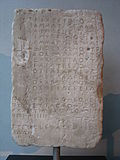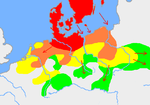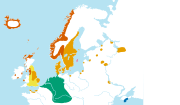In phonetics and phonology, a sonorant or resonant is a speech sound that is produced with continuous, non-turbulent airflow in the vocal tract; these...
6 KB (713 words) - 22:18, 6 June 2024
Syllabic consonant (redirect from Syllabic sonorant)
descender, such as in [ŋ̍]. Syllabic consonants in most languages are sonorants, such as nasals and liquids. Very few have syllabic obstruents (i.e.,...
18 KB (1,974 words) - 23:20, 2 November 2024
Voiceless alveolar trill (redirect from Voiceless raised alveolar non-sonorant trill)
The voiceless alveolar trill differs from the voiced alveolar trill /r/ only by the vibrations of the vocal cord. It occurs in a few languages, usually...
11 KB (789 words) - 02:18, 25 April 2024
Voiceless uvular fricative (redirect from Voiceless uvular raised non-sonorant trill)
The voiceless uvular fricative is a type of consonantal sound that is used in some spoken languages. The symbol in the International Phonetic Alphabet...
23 KB (1,680 words) - 21:10, 21 September 2024
The voiced alveolar trill is a type of consonantal sound used in some spoken languages. The symbol in the International Phonetic Alphabet that represents...
37 KB (1,879 words) - 11:50, 20 October 2024
consonant at the end of a word. voiceless sonorants: clay [kl̥eɪ̯]; snow RP [sn̥əʊ̯], GA [sn̥oʊ̯] syllabic sonorants: paddle [ˈpad.l̩], button [ˈbʌt.n̩] The...
228 KB (23,164 words) - 00:11, 21 November 2024
Obstruents contrast with sonorants, which have no such obstruction and so resonate. All obstruents are consonants, but sonorants include vowels as well...
2 KB (229 words) - 06:19, 25 February 2024
Attic Greek (section Sonorant clusters)
before cluster of sonorant (r, l, n, m, w, sometimes y) and s, after deletion of s. ⁓ some Aeolic: compensatory lengthening of sonorant. PIE VsR or VRs...
24 KB (2,707 words) - 18:48, 12 June 2024
verbs beginning with a single consonant, or a cluster of a stop with a sonorant, add a syllable consisting of the initial consonant followed by e. An aspirated...
48 KB (5,246 words) - 07:27, 21 November 2024
and sonorant consonants: [ḁ], [l̥], [ŋ̊]. In Russian use of the IPA, the voicing diacritic may be turned for voicelessness, e.g. ⟨ṋ⟩. Sonorants are sounds...
6 KB (775 words) - 14:54, 3 October 2024
Gothic language (section Sonorants)
This article contains Gothic characters. Without proper rendering support, you may see question marks, boxes, or other symbols instead of letters. Gothic...
91 KB (10,159 words) - 02:16, 18 November 2024
Sonority may refer to: sonorant sonority hierarchy, a ranking of speech sounds (or phones) by amplitude In music theory, a chord, particularly when speaking...
350 bytes (67 words) - 01:44, 9 March 2019
voiceless sonorant in Icelandic, it instead underwent fortition to a plosive /kv/, which suggests that instead of being a voiceless sonorant, it retained...
112 KB (8,843 words) - 17:12, 31 October 2024
Muscogee language (section Sonorants)
be geminated (lengthened). Some sonorants may also be geminated, but [hh] and [mm] are less common than other sonorant geminates, especially in roots....
33 KB (3,386 words) - 06:33, 15 November 2024
Aeolic Greek (section Sonorant clusters)
consonant cluster with h (from Indo-European *s) and a sonorant (r, l, n, m, w, y) changed to a double sonorant (rr, ll, nn, mm, ww, yy) in Lesbian and Thessalian...
52 KB (2,878 words) - 07:24, 9 October 2024
[−syllabic]. All sound categories falling under [+sonorant] are sonorants, whereas those falling under [−sonorant] are obstruents. In this way, any contiguous...
18 KB (2,109 words) - 16:26, 3 March 2024
Voiced uvular fricative (redirect from Voiced uvular raised non-sonorant trill)
The voiced uvular fricative is a type of consonantal sound, used in some spoken languages. The symbol in the International Phonetic Alphabet that represents...
28 KB (1,392 words) - 04:54, 17 November 2024
*a, and former *eu had become *jau. Proto-Balto-Slavic also possessed "sonorant diphthongs", consisting of a short vowel followed by *l, *m, *n or *r....
100 KB (11,146 words) - 22:19, 9 November 2024
lateral approximants is ⟨l⟩, and the equivalent X-SAMPA symbol is l. As a sonorant, lateral approximants are nearly always voiced. Voiceless lateral approximants...
48 KB (2,729 words) - 23:23, 9 November 2024
a consonant followed by a vowel such as /ka/ (か); or /N/ (ん), a nasal sonorant which, depending on the context and dialect, sounds either like English...
52 KB (4,209 words) - 13:43, 19 November 2024
was a two-way voiced vs. voiceless distinction among all fricative and sonorant consonants, and up to a four-way distinction among stops and affricates...
106 KB (9,048 words) - 12:09, 16 November 2024
Kagoshima dialect (section Sonorant gliding)
added pronunciations [kaɡoçima] and [kaɡoima]. Sonorant gliding is a phonological process whereby the sonorant syllables /ɽi/, /ɽu/ and /ɽe/ are reduced to...
119 KB (10,355 words) - 12:48, 14 September 2024
stop consonants reconstructed as voiceless, voiced, and breathy voiced; sonorant consonants that could be used syllabically; three so-called laryngeal consonants...
63 KB (5,751 words) - 09:25, 16 November 2024
languages, with a notable exception being Icelandic, vowels and other sonorants (consonants such as m, n, l, and r) are modally voiced.[citation needed]...
12 KB (1,376 words) - 21:54, 7 November 2024
Voiced alveolar fricative (redirect from Voiced alveolar raised non-sonorant tap)
The voiced alveolar fricatives are consonantal sounds. The symbol in the International Phonetic Alphabet that represents these sounds depends on whether...
46 KB (2,717 words) - 19:29, 7 November 2024
fricatives) and sonorants (approximants, nasals, and semivowels). Voice is not a contrastive feature; all obstruents are voiceless and all sonorants are voiced...
83 KB (7,379 words) - 19:40, 29 October 2024
used as a nucleus. An example of this is in Cantonese, where the nasal sonorant consonants /m/ and /ŋ/ can stand alone as their own syllable. In Mandarin...
84 KB (8,874 words) - 14:25, 19 November 2024
English phonology (section Sonorants)
This article contains phonetic transcriptions in the International Phonetic Alphabet (IPA). For an introductory guide on IPA symbols, see Help:IPA. For...
116 KB (12,239 words) - 08:04, 1 November 2024
Proto-Indo-European root (section Sonorant metathesis)
arranged from high to low sonority: Non-labial sonorants *l, *r, *y, *n, denoted collectively as *R. Labial sonorants *w, *m, denoted collectively as *M. Obstruents...
24 KB (2,859 words) - 18:10, 11 August 2024
sonorants. Doubly written consonants of this sort do not occur in positions where tense sonorants developed from non-geminated Proto-Celtic sonorants...
43 KB (3,999 words) - 12:48, 12 October 2024













